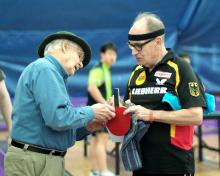In this article, I’m going to classify all table tennis rubbers into one of three basic categories.
Grippy Inverted Rubbers
What you see is what you get. If your opponent strokes the ball with a topspin stroke, the ball will be topspin to some degree or another. Same principle applies to backspin or sidespin.
Recreational Rubbers, Short Pips, and Long Pips with Grip
What you see is not what you get. Even though your opponent might appear to be spinning the ball, the ball will usually be no-spin.
Anti-Spin Rubbers and Long-Pips without Friction
What you see is not what you get. If you impart light spin on the ball, when your opponent returns the ball (even if it appears that he is spinning) the ball will be without spin. If you impart very heavy spin on the ball, then your opponent’s ball with have some spin coming back to you. If you impart very heavy backspin, then the ball with have some topspin coming back. If you impart very heavy topspin, the nthe ball with have some backspin coming back. The trouble that most players encounter is that they impart very little spin on the ball, then are surprised when the pips or anti return comes back without spin. The main point that you must remember is that anti and pips don’t create spin, they just return the ball with your spin.
Pips in a Nutshell

Understand your opponent's weapon
Category:



